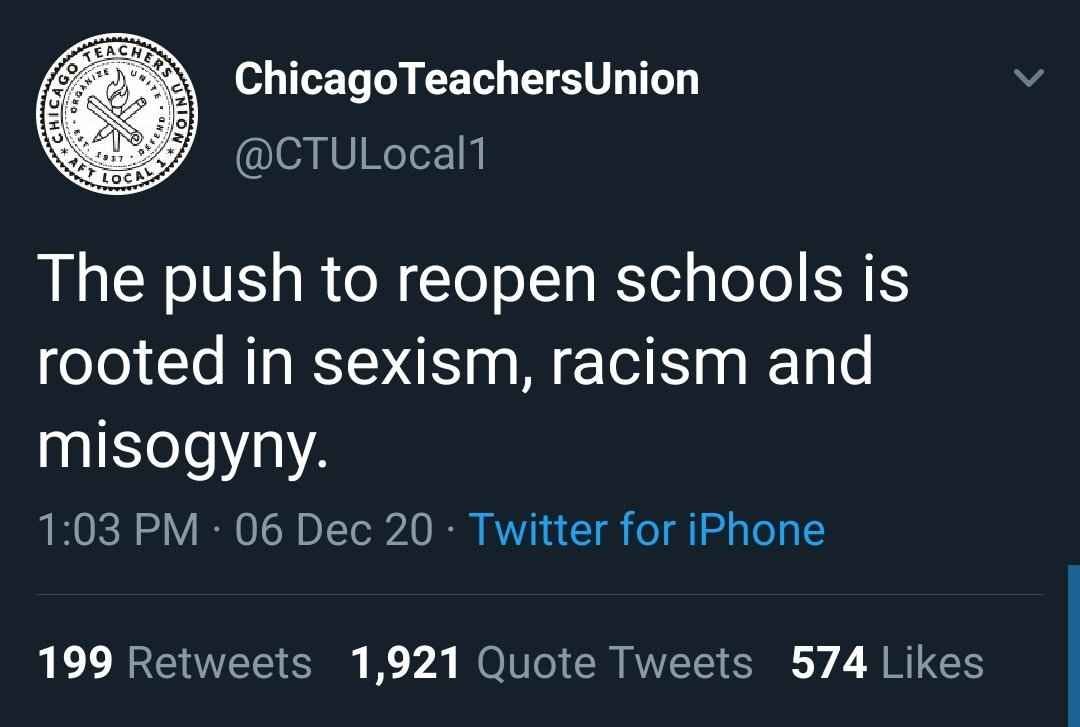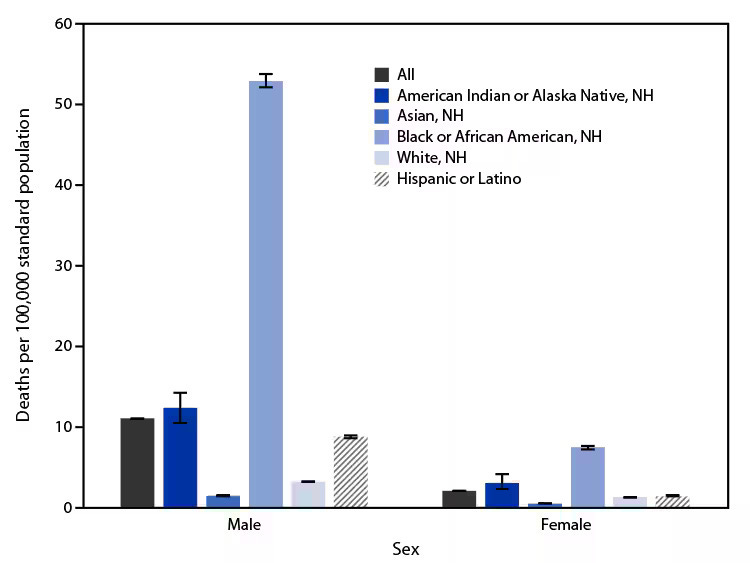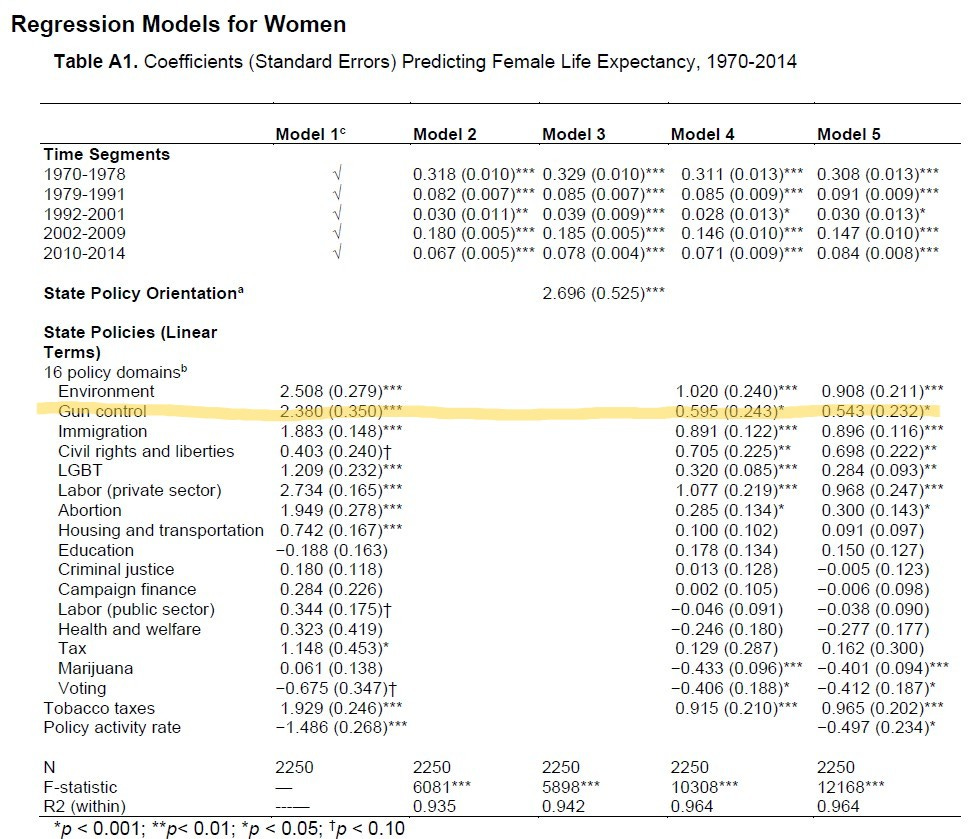In a recent Nature Medicine article titled “Political Polarization and Health”, NYU faculty Jay Van Bavel and Eric Knowles, with collaborators from Syracuse and Columbia, claimed:
“People who live in states with more liberal social policies, such as generous Medicaid coverage, higher taxes on cigarettes, more economic support (for example, minimum wages) and more firearm regulations live longer⁴¹ than their counterparts in states that embrace more conservative policies.”
Their source (the 41 footnote) is an essay by Jennifer Montez (2020) that includes a table with those variables for two states – New York and Mississippi. It’s just a table with some descriptive stats, like the number of gun control laws (75 vs. 5), the minimum wage level (no correction for cost of living), and life expectancy (which are incorrect per her source).
There’s nothing we can do with a table with bits of data for New York and Mississippi. That’s not anything. We can’t make sweeping claims about state laws and life outcomes based on two states. Moreover, none of these claims account for race, which is a major predictor of lifespan, gun violence, health habits, and so on. Mississippi has the largest black population share of all states at 38%. To talk about any of these variables without controlling for race is scientifically incompetent and a waste of everyone’s time.
On X, I notified Knowles and Van Bavel about their false claims. Knowles replied that I hadn’t read the rest of the Montez essay.
The essay has no analyses or models. There are no statistics in the text, or any other tables. It’s an essay, not an empirical paper. There are some sweeping claims in the text, but they’re false (see below), so no, their source is invalid and their claims are false in that there’s no support for them.
Remarkably, Van Bavel and Knowles made their false claims causal by placing them under the heading “How does polarization impact public health?”, and the paper is saturated with causal assumptions. “Polarization” to them means the existence of conservatives, libertarians, moderates, and other non-leftists — i.e. the lack of leftist hegemony over America. It’s quite Orwellian — when they say polarization harms health, they mean that not having all their preferred authoritarian leftist policies in force in all fifty states harms health.
Knowles later (on X) retreated to claiming that a different paper — Montez, et al. (2020): US State Policies, Politics, and Life Expectancy — backed their claims, even though they didn’t cite it.
That’s an actual empirical paper, but it doesn’t do anything for us. It’s not clear what the researchers did because they don’t say, but the only analyses of life expectancy are for men and women separately, they didn’t model the number of gun laws at all, or the minimum wage level and Medicaid coverage specifically, and there’s no effect of their “gun control” variable on male life expectancy, just female, which looks impossible given the data (below). The study is invalid (also below), so there are no effects we can take from it, it doesn’t match the claims Van Bavel and Knowles made, they never cited it, and their claims were drawn from the table in the Montez essay that they did cite.
Strange exclusions
Since the the claims are false, they must be corrected. They’re central claims in the paper, which is a remarkable artifact — they only attempt to show the benefits of authoritarian leftist policies. They don’t present any evidence for the harms of such policies or the benefits of non-leftist approaches, and they didn’t bring in any non-leftists, conservatives, libertarians, etc who could’ve countered their biases and improved the quality of the paper. There’s no attempt at rigor, balance, or weighing of evidence. There’s no evaluation of evidence quality, and they credulously cited a debunked, extremely low quality study claiming that Republicans died more because fewer of them were vaccinated for COVID (though a majority were), but they didn’t cite the debunking or notice themselves that the study was invalid (a fuller treatment by Prasad here). In 2024, they still relied on notorious leftist misinformation, such as the sudden, arbitrary belief that masks — even cloth masks — reduce COVID infection rates, a belief for which there is no quality evidence and which the only published randomized trial did not support, and social distancing, which Anthony Fauci had already conceded had no scientific support. The paper is full of arbitrary authoritarian leftist beliefs and superstitions, which they treat as though they were simple, established facts, not unsupported, contested, or debunked.
Perhaps the most notorious leftist policy misstep was prolonged school closures, which were extremely harmful to children, especially in learning loss, yet Van Bavel and Knowles don’t mention it. It’s a vivid example of polarization because leftist teachers lobbies reversed their position on reopening schools in Fall, 2020 simply because President Trump called for it (Levinson, Geller, and Allen, 2021 — see section 3). Such a severe, reactive partisan mentality is disturbing when it impacts children, learning, and health (there were many health impacts of school closures). And leftist ideology was front and center in posts like this from the Chicago teachers union:
Explaining the cult ideology expressed in this tweet is out of scope here, but you can see how freely leftists assert the motives of strangers who take mundane policy positions and of parents who wanted their kids back in school. (Contemplate the fact that these extremists are teaching children.)
Yet Van Bavel and Knowles exclude all traces of how the left behaved during COVID — the scientific illiteracy, reactive partisanship, authoritarianism, and dogmatic hatred and dehumanization of people who declined an experimental pharmaceutical product that wouldn’t tangibly help most people, etc.
Nor do they cite the many harms of the lockdowns, the harms of COVID shots, especially to young people in relation to the faint benefits, or how so many Americans lost their jobs for declining the shots (most of whom had already had COVID). That’s a rather severe harm to innocent people, as is denying transplants to children who didn’t get the shots. COVID isn’t relevant to most people in terms of mortality or hospitalization risk, the shots don’t prevent infection or transmission (many leftists still seem unaware of this fact, even as they keep getting COVID — it’s a confusing situation), and there’s no apparent case for giving them to children — it’s not common around the world and I’m not aware of any published cost-benefit analyses, which would be difficult given the lack of randomized trials and the subjectivity of the weights assigned to the unknown long-term risks of new pharma. Yet even children are denied organ transplants over an irrelevant pharmaceutical product. Leftists’ obsession with forcing people to get COVID shots is worth researching from psychological and science literacy standpoints (Do they know that they don’t prevent infection or transmission? That non-elderly healthy people aren’t at risk from COVID?, etc.), as are any harms ensuing from said obsession.
Finally, it’s awkward to discuss politics and health without addressing what is arguably the worst medical scandal in history — the mutilation and sterilization of thousands of children on new leftist “trans” ideology grounds. In America, the sterilization started in 2007 at Boston Children’s Hospital (Biggs, 2022), and mutilating surgeries started by 2012 at the latest. Indoctrination in leftist trans ideology is widespread in schools nationwide, even in elementary, and it seems to have started in the last decade (examples here). Over 6,000 children age 12+ have already been mutilated, mostly girls whose healthy breasts were cut off, with a few hundred genital mutilations (castration, penectomy, vaginectomy, vaginoplasty, etc.; all published estimates summarized here). Thousands have likely been sterilized by wrong-sex hormones, usually given after puberty blockers, which are implanted in children as young as eight (tens of thousands of children have been given blockers and/or hormones — the sterilization rate is unknown, and varies by sex and other factors). For some children, blockers permanently destroy their ability to orgasm before they’ve ever experienced it. The victims are disproportionately autistic and in poor mental health.
As of 2025, leftist-controlled states continue to sterilize and mutilate children, while most conservative states have banned the practice, joining Britain, Finland, Sweden, and Norway (this is only happening in the West, as it’s a Western leftist ideology). This scandal snuck up on us, is difficult to comprehend, and hard to communicate to the unfamiliar without meeting disbelief. For unclear reasons, American leftists/liberals suddenly acquired metaphysical beliefs in “trans children”, extending the academic left’s “gender identity” ideology and constructs. We face a situation where seemingly millions of Americans believe that a boy can actually be a girl, and vice versa, though it’s not clear what that means. There’s near zero communication between leftists and non-leftists/dissident leftists on this topic, nor any research into this cult psychology. They apparently believe that a child can be “born in the wrong body”. We have countless parents — usually mothers — asserting that they knew their son (who they call their daughter) was “trans” at age four or even two because of trivial behaviors like preferring the color pink or putting on a dress. The children look like hostages in many of the videos: here are several illuminating clips, including a detransitioner. Be warned — they’re disturbing. There’s no research, so we’re limited to direct engagement, which is perhaps fortunate. This scandal is obscured by Orwellian doublespeak like “gender affirming care” and wildly false claims that the mutilation and sterilization are lifesaving.
Sterilizing a child, making children lifelong medical patients, cutting off their healthy breasts, castrating them, etc. is all extremely harmful to health and violates our basic principles of consent and human rights. It’s unconscionable to exclude this issue when purporting to survey the impact of politics on health in the United States.
Back to the false claims Van Bavel and Knowles made — let’s dig into the idea that the number of gun laws, or “gun control” generally, could increase life expectancy, and look the Montez, et al. study.
Gun control
The idea that the number of state gun control laws – the number – would account for longer life expectancy seems mystical. It ignores where guns land on causes of death, it’s a mindless, contentless variable, and in the hands of partisan social scientists extremely vulnerable to manipulation. First, how would any state gun control laws increase life expectancy? What sorts of laws are we talking about? By what mechanisms would they increase life expectancy? Why wouldn’t gun control laws reduce life expectancy?
A core problem is that there isn’t much variance in America in terms of the ability of most people to own firearms. The right to keep and bear arms is formally recognized in the US Constitution. In every state, if you’re an adult and don’t have a criminal record or severe mental health history, you can go buy a firearm. (I don’t know about DC.)
Firearms are extremely helpful in stopping crimes, usually without having to fire them (see English, 2021). We might expect broad firearms ownership to increase life expectancy by reducing the murder rate by preventing murders, but murder is extremely rare, clustered in criminal populations, accounts for <1% of all deaths, and some of the defensive uses of firearms will kill the murderer (like the story on top of this article about the pregnant woman with the AR-15) — that would be a wash on life expectancy estimates. Only a third of the population reports owning firearms, that share has only slightly increased over time, and most gun owners don’t carry their weapons, so effects are hard to detect. (However see Moody and Lott (2024) for evidence that right-to-carry laws reduce the murder rate and Constitutional carry1 laws reduce rapes, though I’m not endorsing their study without spending more time with it, and such effects won’t matter for life expectancy estimates.) Firearms are most helpful in stopping the more common crimes of robbery, burglary, rape, assault, etc. — you’re very unlikely to face an attempt to murder you if you’re not a drug dealer or similar.
What gun control laws do states have that would plausibly increase life expectancy? I’m not sure. To increase life expectancy, they’d have to reduce the murder rate. Not the gun homicide rate — firearms can be substituted, so we have to focus on the murder rate to avoid missing a shift in methods. A 5% reduction would be <0.05% of deaths. Key is how a gun control law, e.g. a magazine capacity limit, would cause that reduction.
Suicides can be ignored for our purposes since state-level gun control doesn’t change the reality that anyone without a record can go buy a handgun, in all states, and alternative methods are easy. A magazine capacity limit or a ban on AR-style rifles isn’t relevant to the ability to take one’s own life with a firearm. Suicides are <2% of deaths annually, so if we reduced suicides by 5%, that’s <0.1% of deaths (though the rates vary by state). There are also ethical problems in assuming that all suicides should be prevented — these are people, lives, and contexts we know nothing about. The ethical issues wouldn’t impact life expectancy analyses, but they undermine the remarkable premise that we should engage in mass coercion to prevent some number of suicides we know nothing about.
(Accidental gun deaths are the most rare type at a few hundred per year, about 0.001% of deaths, so no dice.)
What did Montez, et al. do? It’s not clear. This is the uncited study that Knowles ultimately fell back on. Montez, et al. said they looked at nine gun control laws from 1970 to 2014, and gave a binary 0 or 1 score to states for each law, where 1 marked the presence of the leftist law, and 0 marked a conservative policy/the absence of the law. They said “a state's annual score for each policy domain was calculated as the sum of the liberal policy scores minus the sum of the conservative policy scores”, but this makes no sense since the conservative scores are zero — subtracting them does nothing. Note also that this is not the count of gun laws that Montez cited in her essay/table, which Van Bavel and Knowles cited — that was from Siegel, et al. (2017). This is not a count.
The nine categories under Gun Control:
The core method is invalid, and there are several problems with this list:
The Brady law is a federal law mandating background checks, which took effect in 1998. Background checks are a nationwide reality — it’s not clear what state variance one could capture, or how it could plausibly increase life expectancy.
The federal government banned “assault weapons”2 from 1994 to 2004. It’s not clear what state variance one could capture in that span, or how it could plausibly increase life expectancy. (Fewer than 5% of gun homicides, which are a subset of all homicides, were with rifles of any type.)
It’s not clear what “background checks (dealers)” and “(private)” refer to, or how they could plausibly increase life expectancy. Gun buyers are subjected to background checks at dealers in all states — that’s the Brady law.
All dealers are required to have a Federal Firearms License (FFL). It’s not clear what “dealer license required” refers to, what state variance one could capture, or how it could plausibly increase life expectancy.
Note that each of these categories was given a binary coding of 0 or 1. The authors offer no explanation for any of them — there’s literally no explanation in the paper — and they don’t provide their data, codings, etc. We can’t see anything.
Apparently, we’re just supposed to believe that “gun control” below means something, without knowing what it means.
The authors don’t fully describe their models — only Model 1 is even mentioned in the paper, and these tables are hidden in the Supplemental Materials. At least one of the fuller models controls for unemployment rate, but it’s not clear which. There’s no significant effect for men with the fuller models, and it starts to go negative.
Note that they didn’t control for race, which makes this useless, though this research is already invalid.
Recall that Knowles claims the above unspecified study and irrelevant results support this statement:
People who live in states with more liberal social policies, such as generous Medicaid coverage, higher taxes on cigarettes, more economic support (for example, minimum wages) and more firearm regulations live longer than their counterparts in states that embrace more conservative policies.
There’s no model for people as such (just men and women separately), there’s no count of gun control laws, and cigarette taxes is the only variable that exists here. Minimum wage (apparently uncorrected for cost of living) is buried in “Labor (private sector)” with eight other variables. “Generous Medicaid coverage” is either buried in “Health and welfare” as “Medicaid expansion” with 14 other variables, or it’s not here at all, depending on what they meant.
We have no idea what the correlations are between those variables and life expectancy — for men, women, or people as such. Van Bavel and Knowles have no support for their claims, even if we believed the Montez, et al. analysis, which we definitely should not.
Typing “gun control” is easy
I too can type “gun control” and put some numbers next to it.
Gun control: 2.358, p < .01
Voila! Science!
That’s not anything. As we’ve seen, we don’t know what Montez, et al. did with their gun control variable. We don’t know what their categories mean, why they match federal laws, or the scores they assigned states. But there’s a deeper issue — their method is invalid on its face and should never have been published.
Why would we allow partisans to make a list of policies? We can make lots of lists of nine or five or fifteen gun control laws — what makes their list valid? This method is completely arbitrary — in the selection, the number, and the math.
This method also gives equal weight to each policy. Why? Why should open carry count as much as whatever “background checks (dealers)” means? States that allow open carry allow you to visibly carry a firearm, typically holstered, as opposed to concealed carry. Only four states currently ban open carry, so there’s not much variance, and it’s an extremely rare behavior (I’ve only seen one person openly carry in Arizona). It’s not relevant to crime since criminals don’t tend to walk around with visible holstered weapons.
If you’re familiar with the gun control debate in America, you’ll notice that Montez, et al. excluded the two most prominent issues from their list — concealed carry and magazine limits. Why were they excluded? I have no idea, but the method is fundamentally invalid — it wouldn’t be made valid by adding missing issues. Note that adding issues would arbitrarily change the math and the results.
The core issue is that academics in the social sciences are allowed to invent arbitrary, often undisclosed methods. This is very unlike the physical and life sciences, where the methods are established, validated, and familiar to reviewers. In social science, it’s common for reviewers to never have seen the method before. They don’t think deeply about them, and allow researchers to just claim that they measured “gun control”, “misinformation”, or “racism” (example item for “racism”: “It is easy to understand the anger of black people in America” — disagreement or even neutrality scores you as “racist”). Reviewers are dazzled by complex inferential statistics that they won’t validate or even understand, and they don’t look at the data — no one looks at the data, even to see that it exists. As usual, no data was supplied with the Montez, et al. study — we should stop talking about research for which there is no data, and all such research should be retracted by journals and removed from the literature.
The methodological flexibility of social science means that there are hundreds of ways we could measure something as broad as “gun control”, multiplied by many different choices we can make in our inferential statistical modeling. Journals will publish anything if it advances leftist narratives and power, especially if it makes conservatives look bad.
For example, we could’ve chosen a different, longer list of laws, and broken them into four groups. For the first group, we’d assign states scores from 0-6. For the second, we’d assign scores of 0-3. For the third, we’d assign scores of 0-1.5. And for the fourth, we’d assign scores of 0-1.
Then we’d sum the scores and correlate that sum score with “gun deaths” (mostly suicides), controlling for nothing at all — just a simple Pearson correlation. And note that a “gun deaths” variable is nifty because it can easily mislead readers by hiding increased or flat murder and suicide rates.
To make it really tricky, we could violate spacetime by correlating gun laws as of January 21, 2025 with gun deaths from 2023, as if gun laws passed in 2024 could have saved lives the year before…
I just described the method used by Everytown, a leftist gun control lobby founded by Michael Bloomberg. Their data and ratings/methods are secret beyond the description I gave above. (They do tell you what laws are in each group, but they don’t explain their scoring process beyond that, e.g. what sort of legal reality would get a state a 0, 1, 2, 3, 4, 5, or 6 on the Stand Your Ground law category, or any other category.)
Montez, et al. did something that they didn’t describe, and it turns out they got impossible results as far as gun control laws actually causing an increase in life expectancy.
Life expectancy
Life expectancy has been going up everywhere for over a century because of the industrial revolution and capitalism, and the resulting gains in standards of living and advances in technologies relevant to survival, like sanitation, transportation, logistics, affordable oil/gas for heated homes, health care, antibiotics, etc. (Vaccines have saved millions of lives, but came after the major gains in life expectancy, mostly in the 1960s and 70s.)
Montez, et al. plugged their lists of leftist policies — converted into invalid composite scores — into the trend you see above.
The problem is that lawmaking increased dramatically in the 1970-2014 period they chose, in all states — mostly leftist-oriented laws. It’s not clear how plugging in anyone’s lists of laws is valid unless you control for all the obvious things, like standards of living, race, and well, all the things we know predict life expectancy.
We could test other lists of laws, but I’m not sure there’s any valid list-of-laws method, especially if the obvious predictors of life expectancy explain away all the variance.
Moreover, we can separately invalidate their claims with simple reality check math.
Life expectancy is calculated with life tables. Like this one I got from the CDC for 2010 (randomly chosen year relevant to Montez, et al.).
For now I’ll just point you to the highlighted cell. That person-years figure is cumulative — it’s the sum of all the values in the previous column: the annual person-years [L(x)].
Life expectancy is that total person years figure divided by 100,000 — the numbers are all out of 100,000, which is why the first cell under survivors is 100,000.
It’s 78.7 for people born in 2010.
Okay, so if state gun control laws reduced the murder rate in a state by 5%, that’s less than a 0.05% reduction in deaths if the state’s death and murder rates are similar to the nation’s.
A 0.05% reduction in deaths is much less than a 0.05% increase in life expectancy, since the death rate is only ≈1%. Right now, I don’t know how to do the correct math on that life table, in part because the probability of being murdered will vary by age (and it should be controlled for race anyway). I’m curious enough about this that I’ll probably learn and come back to it.
Recall that Montez’s only significant effect of their mysterious gun control variable was on women’s life expectancy. That presents another logical/math problem — women are killed by guns at much lower rates than men.
This is firearm-related homicide deaths for 2021, per the CDC. As you can see, women are about a fifth as likely to be killed this way, so moving around their life expectancy is even more implausible given the math above.
How about suicide?
These are suicide rates by sex and method, for 2000-2018, per the CDC.
Again, there’s no plausible mechanism by which state gun control laws — open carry, magazine limits, etc — could reduce suicide rates, but the basic suicide data makes the idea even more tenuous. Reducing a 0.006% death rate (6 per 100,000) by even 10% is not going to show up in life expectancy estimates, and this combined with a similar effect on gun homicides simply cannot increase life expectancy by a half year, as Montez, et al. reported:
So even if these laws — which they didn’t explain and which duplicate federal laws — could somehow reduce murder and suicide rates, they could not have had the reported effects on life expectancy.
Often, basic logic and exogenous real-world data debunks academic research. This is underexposed because no one is systematically evaluating academic research. Our civilization is still stuck in an unfortunate place where we don’t understand that journals will publish anything, much of it false, and that academic researchers can be trivially debunked by outsiders doing basic fact checking3 and reasoning.
A good way to capture the invalidity of a lot of academic research is to ask yourself how you’d approach a question.
Q: Do state gun control laws increase life expectancy?
You’d probably want to throw out the question because of the reasons noted above, but whatever you came up with, you wouldn’t make that list of nine leftist gun control laws, generate a composite score from them by any method, much less theirs, do the same for a bunch of other partisan leftist topics, and regress life expectancy, which is on a 150-year upward trend, on such variables while not controlling for race, standard of living, burden of disease, etc.
I recommend thinking about how you’d answer a question or test a hypothesis before you read journal or news articles about them. You can do this from the headlines. Maybe write down a summary of what you’d do, then read the article. It’s fun, and you’ll be shocked by the invalidity and stupidity of the methods that academics used instead. Prometo.
Joe Duarte grew up in small copper mining towns in Southern Arizona, earned his PhD in social psychology, and focuses on political bias in media and academic research. You can contact him at gravity at protonmail.com.
Right-to-carry laws allow people to carry concealed handguns with a permit that anyone can obtain if they meet the criteria (clean record, maybe a short course). Constitutional carry is the right to carry a handgun, either concealed or open, without a permit.
“Assault weapons” are defined as semiautomatic rifles with detachable magazines and superficial features like a flash suppressor, pistol grip, or folding stock.
A great example is Kelly K, a Georgia mom who got journal authors and the CDC to correct their overestimates of children killed by COVID. She’s the basis of this Reuters story that doesn’t mention her.












Thanks for the article.
Unfortunately, social science has been like this for decades.
With regard to "This is very unlike the physical and life sciences, where the methods are established, validated, and familiar to reviewers." I think you are overestimating the quality of natural science research a bit. Sure, it's probably better than social science research (a very low bar indeed). But I've seen firsthand how much life science consists of using inferential statistics in the same sort of incognizant way.
With regard to 'It’s not clear what “background checks (dealers)” and “(private)” refer to...' Some states (like here in Virginia) have redundant background check laws, so when you go to buy a firearm, you fill out two forms, one for the federal background check and one for the state background check. Obviously, this is unlikely to affect life expectancy in any way.